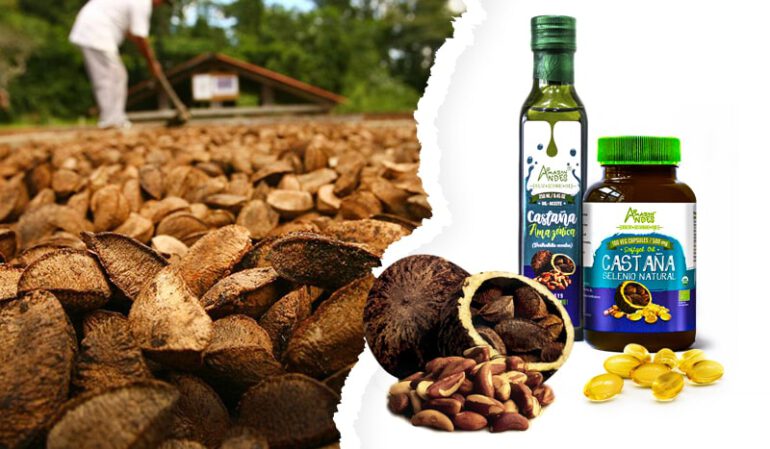Brazil Nuts Oil
Origin and History:
The Brazil Nuts tree is one of the tallest trees in the Amazon (it reaches more than 50 meters high), is located in the region of Madre de Dios in Peru, Acre in Brazil and Pando in Bolivia; it is able to tell stories from over a thousand years of history. Undisputed king of the vegetation of the jungle, it has a treasure in the form of wooden capsules, where a wealth for the palate and organism is stored. Brazil nus, a tasty and healthy dry fruit, source of energy, fiber and protein without calories is one of the main ingredients of food for children and newborns.
Brazil Nuts contain approximately 67% of oil, obtained through the pressing of the seed. After extra filtration, extra virgin oil is obtained, extracted from the first pressing.
Brazil Nuts oil, in addition to being edible and being part of the diets of the Indians and mestizos of the Amazon, who consume the almond, contains “selenium”. These raw materials are traditionally used as digestive, healing; fights anemia, tuberculosis and beriberi.
Brazil Nuts oil is characterized by its pleasant taste, it is a gourmet oil that improves the taste of raw vegetables. It contains 36.1% of omega 6 and 39.3% of omega 9, it contains 88% more vitamin E (tocopherols) than other oils and also more selenium in addition to phosphorus, potassium, magnesium, iron, calcium, vitamins C and B2.
It replaces olive oil with its mild and pleasant taste, it functionally helps us fight arthritis for which we must consume a tablespoon of Brazil Nuts oil in the morning on an empty stomach and before bedtime. To reduce cholesterol, add two tablespoons of Brazil Nuts oil daily to salads. Being rich in unsaturated fats, which have a tendency to reduce the level of cholesterol in the blood.
Traditional Use:
- Contains antioxidant agents and is anticancer.
- Moisturizes the skin, nourishes it and leaves it soft.
- Decreases the chance of getting cardiovascular diseases.
- Brazil nuts are an energetic and nutritious food (rich in protein and healthy fatty acids)
- Decreases cognitive impairment over the years.
- Prevents inflammation of the thyroid gland.
Principal benefits:
- Contains 88% more vitamine E than other oils
Brazil Nuts oil, containing more vitamin E than other oils, gives it a great antioxidant power, protecting our cells from damage caused by free radicals. - Contains omega 6 and 9
Brazil Nuts Oil is a source of omega 6 and 9, helping hair growth and skin care. It also helps improve concentration and promotes memory, as well as lowering bad cholesterol (LDL) and increasing good cholesterol (HDL). Increases defenses. - Contains phosphorus, potassium, magnesium, iron, calcium, vitamins C and B2
The vitamin B it provides can be fully used if consumed raw, it protects the nervous system. Its B2 content is beneficial for skin care. Regarding minerals, its contribution in potassium stands out, which helps control fluid retention, in hypertension, promotes protein synthesis and allows the conversion of hydrates into glycogen. The iron provided by Brazil Nuts helps prevent anemia and headaches. By containing phosphorus, calcium and magnesium, it will help protect bones, provide energy, also helping in metabolism. In addition to improving nerve transmission. It is an outstanding source of vitamin C, essential to be able to absorb iron and manufacture red blood cells as well as being a good antioxidant, helping to prevent aging. - Contains a smaller amount of unsaturated fats.
Brazil Nuts oil is the one with the highest linoleum acid content, which is beneficial for lowering cholesterol and preventing heart attacks and atherosclerosis. It can be used just like any other type of oil, being just as healthy.
- Contains antioxidant agents
Brazil nuts is one of the few fruits with high selenium values, values of 0.03 to 512 ppm of this element were obtained with fresh samples from different regions of the Brazilian Amazon.
The presence of selenium in the diet has been associated with the protection against the development of tumors in studies with laboratory animals, specifically in the inhibition of breast cancer.
- Has a not very intense flavor
Being a dried fruit, the taste of its oil is very mild, so that it does not change the flavor of foods, it can be consumed with salads and other foods, without losing the characteristic flavor that characterizes them.
- Prevents cognitive impairment
Selenium levels in the blood decrease as people get older, and scientists study whether low selenium levels contribute to impaired brain function in the elderly. Some studies indicate that people with lower levels of selenium in the blood are more likely to have poor cognitive functions.
- Excellent nutritional contribution
Brazil nuts oil has an excellent composition of essential fatty acids and provides a considerable amount of protein, lipids and vitamins that makes it an excellent nutritional source. It contains selenium. It is an excellent source of sulfurized amino acids, methionine and cysteine.
- Aids in the proper functioning of the thyroid gland
The thyroid gland contains high amounts of selenium that play an important role in thyroid function. Studies suggest that people (especially women) who have low levels of selenium (and iodine) may develop thyroid problems. However, more studies are needed to reach a definitive conclusion.
Contraindications:
By containing selenium, it can have harmful effects if consumed in abundant amounts and cause diarrhea, irritability, garlic breath or with metallic flavors, nausea, brittle hair or nails, skin rashes, discoloration of teeth and nervous system problems. (National Institutes of Health, USA).
The maximum dose to be taken is 400 mcg (micrograms) per day for adults, while for children it is 150 mcg.

